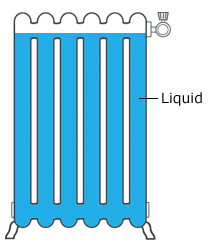Effects of temperature on liquidsThe solid radiator is actually filled with water, a liquid.
Here we'll look at
- What happens to a liquid's particles when they are heated up
Select each temperature
Cold
The particles in a liquid have moderate attractive forces. So the particles are held quite closely together.
But they do not have a fixed position. There is some freedom of movement within the liquid's boundaries, and spaces between the particles.
Warm
Energy, in the form of heat, has now been supplied to the liquid. The additional energy causes the particles to move faster and the spaces between them to get bigger. In other words, even when just warm:
- A liquid is already showing visible signs of expansion
Hot
Here, the particles have lots of energy and whiz about, causing the liquid to expand even more.
Some particles may even break free and escape as a gas through evaporation. If more heat is added, the liquid will eventually boil and all the particles will escape as gas.




